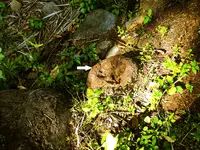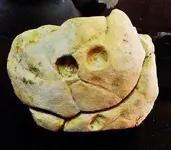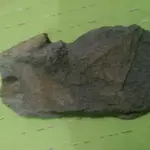You are using an out of date browser. It may not display this or other websites correctly.
You should upgrade or use an alternative browser.
You should upgrade or use an alternative browser.
Stone marker?
- Thread starter Staffhaws
- Start date
tabu
Full Member
It would make a nice conversation piece on a TGIF beer and barbeque chill-out. If it was meant to be found out fast like items in an Easter Egg Hunt for kids then you have a reason to open another can of malt.
Imagine if you think that Yamashita's treasure trove was a steaming-hot bowl of Ramen and the gold bars slivers of chicken and crabmeat under the noodles and veggies and all you have to do is slurp your way down to pick them out with the chopsticks, then you might be in for a big surprise.
Polite and reticent as ever, the Japanese will not tell you that it's not chicken and crabmeat: it's sushi and it's served on another plate and the plate is not even on the table you're dining in.
Like a slice of seaweed in the Ramen, that beautiful piece of engraved stone might be the beginning of a never-ending search. The plate of sushi is somewhere beyond the reach of your chopsticks.
-- tabu
But then,
Treasure hunting, as in any avocation, is all about tempering one's expectations..
Imagine if you think that Yamashita's treasure trove was a steaming-hot bowl of Ramen and the gold bars slivers of chicken and crabmeat under the noodles and veggies and all you have to do is slurp your way down to pick them out with the chopsticks, then you might be in for a big surprise.
Polite and reticent as ever, the Japanese will not tell you that it's not chicken and crabmeat: it's sushi and it's served on another plate and the plate is not even on the table you're dining in.
Like a slice of seaweed in the Ramen, that beautiful piece of engraved stone might be the beginning of a never-ending search. The plate of sushi is somewhere beyond the reach of your chopsticks.
-- tabu
But then,
Treasure hunting, as in any avocation, is all about tempering one's expectations..
Last edited:
tabu
Full Member
If this piece of rock was taken from a stratum of similar composition-- "all black sand with cement"-- then it is unlikely a positive sign as the majority of readers will attest to. However, if it was a discrete fragment imbedded in an "alien" ground, then it's possibly a sign. Again, Rangler, Casca and others have aptly mentioned that a sign to be a valid one has to be taken in the CONTEXT of the environment where it was found. It has no value by itself.
Even if one has a book of Japanese treasure signs, knowledge and familiarity will not be of much use unless a deeper appreciation and understanding of what they represent exist.
At this point I would just like like to remind myself as well as others that the ART of deception (i.e., use of decoys, etc.) is totally different from the SCIENCE of concealment with regards to the burial or hiding of looted treasure (Yamashita gold!) as done by the Japanese during World War II particularly in the Philippines.
If one is fortunate enough to see through the "haze and maze" as deception and concealment are intertwined, then it is possible to find the safest and shortest distance from point A (portal of entry) to point B (treasure location) as I've always believed that the people of the JIA had a shortcut for every hidden wartime loot and more importantly one that is free from hazardous obstacles like booby traps.
--tabu
"To know is good. To understand is better. To realize is best."
Even if one has a book of Japanese treasure signs, knowledge and familiarity will not be of much use unless a deeper appreciation and understanding of what they represent exist.
At this point I would just like like to remind myself as well as others that the ART of deception (i.e., use of decoys, etc.) is totally different from the SCIENCE of concealment with regards to the burial or hiding of looted treasure (Yamashita gold!) as done by the Japanese during World War II particularly in the Philippines.
If one is fortunate enough to see through the "haze and maze" as deception and concealment are intertwined, then it is possible to find the safest and shortest distance from point A (portal of entry) to point B (treasure location) as I've always believed that the people of the JIA had a shortcut for every hidden wartime loot and more importantly one that is free from hazardous obstacles like booby traps.
--tabu
"To know is good. To understand is better. To realize is best."
Last edited:
tabu
Full Member
Another example of a stone marker, a broad arrow superficially engraved and was only appreciated after a photo was taken (at an angle to emphasize relief) with a digital camera. A Yamashita marker? Hard to say but evidence is at best circumstantial. However, a good distance away near a tributary an abandoned Japanese military vehicle long cannibalized and rusted away once stood (so the old farmhands claimed). The stone is just a float (probably buried at a shallow depth and somehow found the light of day by normal process of soil erosion) but it is surrounded by 3 big boulders too heavy to lift except with a hoist or chain block.


Last edited:
tabu
Full Member
With all due respect, I would still insist on not belaboring the obvious. Perhaps the answer lies in watching a Kabuki play.The real answer is behind the actor's mask..
Wish you all the luck! And dig safely.
tabu
Wish you all the luck! And dig safely.
tabu
joshua2004
Jr. Member
- Joined
- Jan 31, 2015
- Messages
- 25
- Reaction score
- 4
- Golden Thread
- 0
- Primary Interest:
- All Treasure Hunting
Hi Tabu,
Thanks for more info. Yes Its look like kabuki mask.
Hope I will dig in exactly location.
Hope you will give me more tips about this site.
At the Back of this Footprint their have also small turtle sleeping and a big turtle facing on the footprint.
Thanks for more info. Yes Its look like kabuki mask.
Hope I will dig in exactly location.
Hope you will give me more tips about this site.
At the Back of this Footprint their have also small turtle sleeping and a big turtle facing on the footprint.
tabu
Full Member
Please indulge me with this annoying habit of tacking postscripts at the end of my comments:
1. I've seen heart signs and turtle signs by their lonesome and I've seen them "eyeball to eyeball" in the field.
2. Invariably heart sign ground is dug up. Surely, the level of frustration and dismay is directly proportional to the depth of the pit. And yet the diggers remain in high spirits or shall we say, hopelessly full of hope.
3. One such heart sign pit dug by a group of full-time TH'ers yielded nothing, hence abandoned.
4. There must be a caveat somewhere hidden among the bushes that says a good number of these can be the cause of much back pain and heart attack if misconstrued.
5. What I'm trying to drive at is that an obviously well-placed heart sign in full view of whomsoever passes by is no guaranty that there is something to hope for except a water table at around 35 feet deep (at least in our neighborhood).
6. The one mentioned in number 3 was actually a landmark and the goodies the guys were searching for was buried a few hundred feet away (so others did say).
Just keep your fingers crossed and best wishes.
tabu
1. I've seen heart signs and turtle signs by their lonesome and I've seen them "eyeball to eyeball" in the field.
2. Invariably heart sign ground is dug up. Surely, the level of frustration and dismay is directly proportional to the depth of the pit. And yet the diggers remain in high spirits or shall we say, hopelessly full of hope.
3. One such heart sign pit dug by a group of full-time TH'ers yielded nothing, hence abandoned.
4. There must be a caveat somewhere hidden among the bushes that says a good number of these can be the cause of much back pain and heart attack if misconstrued.
5. What I'm trying to drive at is that an obviously well-placed heart sign in full view of whomsoever passes by is no guaranty that there is something to hope for except a water table at around 35 feet deep (at least in our neighborhood).
6. The one mentioned in number 3 was actually a landmark and the goodies the guys were searching for was buried a few hundred feet away (so others did say).
Just keep your fingers crossed and best wishes.
tabu
Last edited:
tabu
Full Member
Hi Josh,
Getting bored mentally is a lot worst than physically fatigued. Let's play a little game. There are no rules. One might find a long-lost keychain after raking all the fallen leaves on your yard, so to speak. Or to realize that beneath the superficial layer of bullsh---it lies genuine crap. But first of all, 1. Determine the age of the tugas tree (just inquire from the old folks). 2. Study the area carefully on your computer monitor screen using Google-earth imagery but keep the data to yourself. 3. Look for other signs in the area using the tree or the clustered signs as starting point (notice the arrangement of the sign stones: Viewed from a distance, they form some kind of pointer or arrow in the direction of the tree which I hope is older than your great grandma). 4. Use your pen and paper to make sketches to make some sense of all the signs you might find. Measurements and compass headings are extremely important. 5. Review your high school math and trigonometry, they might come in handy.
That's all for now. Who knows? -- If you're darn lucky, you might see the actor's face behind the Kabuki mask.. Or if not, collect enough material to write a modern sequel to Lewis Carroll's Alice in Wonderland.
All the best,
--tabu
Getting bored mentally is a lot worst than physically fatigued. Let's play a little game. There are no rules. One might find a long-lost keychain after raking all the fallen leaves on your yard, so to speak. Or to realize that beneath the superficial layer of bullsh---it lies genuine crap. But first of all, 1. Determine the age of the tugas tree (just inquire from the old folks). 2. Study the area carefully on your computer monitor screen using Google-earth imagery but keep the data to yourself. 3. Look for other signs in the area using the tree or the clustered signs as starting point (notice the arrangement of the sign stones: Viewed from a distance, they form some kind of pointer or arrow in the direction of the tree which I hope is older than your great grandma). 4. Use your pen and paper to make sketches to make some sense of all the signs you might find. Measurements and compass headings are extremely important. 5. Review your high school math and trigonometry, they might come in handy.
That's all for now. Who knows? -- If you're darn lucky, you might see the actor's face behind the Kabuki mask.. Or if not, collect enough material to write a modern sequel to Lewis Carroll's Alice in Wonderland.
All the best,
--tabu
Last edited:
tabu
Full Member
Josh,
The stone you're holding with the sign that you think is an arrow is possibly the key to the whole puzzle. It is not an arrow. The 3 grooves of roughly the same length and intersecting at the center is the "map". The tip of one arm represent the old molave (tugas) tree. If there is a stream nearby, try to look for another sign that would represent the tip of a second arm-- the turtle and measure the distance. The the third arm you just try to extrapolate as of the same length and distance from the other two. Drawn on a piece of paper the tips of the sign you think is an arrow actually defines an equilateral triangle and the intersection of the median lines in the center of the said triangle is the possible location of the suspected treasure if there is really one. Finding the location of the third arm maybe a little bit tricky because it could be on either side of the imaginary line drawn between the tugas arm and the turtle arm. Try experimenting using the smaller turtle-- it might indicate the compass direction of either the turtle arm which I think is in proximity of a stream or of the third arm somewhere equidistant from arm #1 and arm #2. Using trigonometric functions would greatly simplify matters as an equilateral triangle has only 3 angles of 60 degrees each.
Personally, that piece of sign-stone evokes in me a sense of deja`vu. But I should warn you. What I'm trying to say is not gospel truth or even a half-educated guess. It's more of an imagination running wild like Alice-in-Wonderland stuff. Therefore, take everything being said with a grain of salt.
-- tabu
The stone you're holding with the sign that you think is an arrow is possibly the key to the whole puzzle. It is not an arrow. The 3 grooves of roughly the same length and intersecting at the center is the "map". The tip of one arm represent the old molave (tugas) tree. If there is a stream nearby, try to look for another sign that would represent the tip of a second arm-- the turtle and measure the distance. The the third arm you just try to extrapolate as of the same length and distance from the other two. Drawn on a piece of paper the tips of the sign you think is an arrow actually defines an equilateral triangle and the intersection of the median lines in the center of the said triangle is the possible location of the suspected treasure if there is really one. Finding the location of the third arm maybe a little bit tricky because it could be on either side of the imaginary line drawn between the tugas arm and the turtle arm. Try experimenting using the smaller turtle-- it might indicate the compass direction of either the turtle arm which I think is in proximity of a stream or of the third arm somewhere equidistant from arm #1 and arm #2. Using trigonometric functions would greatly simplify matters as an equilateral triangle has only 3 angles of 60 degrees each.
Personally, that piece of sign-stone evokes in me a sense of deja`vu. But I should warn you. What I'm trying to say is not gospel truth or even a half-educated guess. It's more of an imagination running wild like Alice-in-Wonderland stuff. Therefore, take everything being said with a grain of salt.
-- tabu
Last edited:
joshua2004
Jr. Member
- Joined
- Jan 31, 2015
- Messages
- 25
- Reaction score
- 4
- Golden Thread
- 0
- Primary Interest:
- All Treasure Hunting
According to my father Japanese camp is near on my place almost 2 kilometers. Most of japanese soldier always going to our place. But my fathers and their parents always moving far to the japanese soldier.
tabu
Full Member
Josh,
How far is the the bato-an from the tugas? And approximately how old is it? If it is not as old as your grandpa, ignore the question.
Is there another landmark beyond the so-called pointer stone 4 meters equidistant from the big turtle and the tugas? I'm just anticipating a question some readers might ask. At 4 meters, the big turtle and the tugas are so close together and that would define a very tight equilateral triangle whose center would warrant exploration only if these landmarks are genuine and the only way to find out is to get dirty-- dig!
Of course, let us not forget that the Joker in his harlequin costume is breathing down our necks as we play with our little game. With an impish smile, he might just whisper that we are in the middle of an elaborate ploy-- Decoys Galore and that we've been had, after more than 70 years post WWII.
Nevertheless, keep going and do some more thinking out of the box. You might have the last laugh, for all we know.
--tabu
How far is the the bato-an from the tugas? And approximately how old is it? If it is not as old as your grandpa, ignore the question.
Is there another landmark beyond the so-called pointer stone 4 meters equidistant from the big turtle and the tugas? I'm just anticipating a question some readers might ask. At 4 meters, the big turtle and the tugas are so close together and that would define a very tight equilateral triangle whose center would warrant exploration only if these landmarks are genuine and the only way to find out is to get dirty-- dig!
Of course, let us not forget that the Joker in his harlequin costume is breathing down our necks as we play with our little game. With an impish smile, he might just whisper that we are in the middle of an elaborate ploy-- Decoys Galore and that we've been had, after more than 70 years post WWII.
Nevertheless, keep going and do some more thinking out of the box. You might have the last laugh, for all we know.
--tabu
Last edited:
- Joined
- Nov 14, 2013
- Messages
- 1,483
- Reaction score
- 1,989
- Golden Thread
- 0
- Location
- Treasure Coast Of Florida
- 🏆 Honorable Mentions:
- 3
- Detector(s) used
- Minelab Equinox 800
Minelab CTX 3030
Garrett AT Pro
Minelab Excalibur 1000 with SEF 10x12 coil
3 Minelab Excalibur II 10 inch
Deus II
EQuinox 900
Manticore
- Primary Interest:
- Beach & Shallow Water Hunting
Treasure in the Philippine. Is this a positive marker on this rock? anyone can help to translate this symbol?
Image like sun and face:
View attachment 1113422View attachment 1113423
Footprint and heart symbol:
View attachment 1113419View attachment 1113421
How about the number 35 as in feet?
joshua2004
Jr. Member
- Joined
- Jan 31, 2015
- Messages
- 25
- Reaction score
- 4
- Golden Thread
- 0
- Primary Interest:
- All Treasure Hunting
what do you mean number 35 as in feet?
NHBandit
Silver Member
- Joined
- Feb 21, 2010
- Messages
- 3,473
- Reaction score
- 3,285
- Golden Thread
- 0
- Location
- Formerly NH now East Tennessee
- Detector(s) used
- Garrett GtaX1250
joshua2004
Jr. Member
- Joined
- Jan 31, 2015
- Messages
- 25
- Reaction score
- 4
- Golden Thread
- 0
- Primary Interest:
- All Treasure Hunting
NHBandit
Nice photoshop
Nice photoshop
joshua2004
Jr. Member
- Joined
- Jan 31, 2015
- Messages
- 25
- Reaction score
- 4
- Golden Thread
- 0
- Primary Interest:
- All Treasure Hunting
NHBandit
Nice photoshop
Nice photoshop
tabu
Full Member
Josh,
Let me guess-- your site must be somewhere in the Central Visayan Islands, in the island of Panay? (I'm somewhere here in southern Philippines in Mindanao where rebels and gov't forces are still fighting it out.) At this stage of your search, frankly, I think it's too premature to break up all those stones with the presumed JIA signs. Correct me if I'm misinformed but unlike Mindanao or Luzon, your region is not on the top list of stashed or buried Yamashita loot. But given the good number of pre-war well-to-do's in your place it would not come as a surprise if what is possibly hidden there were family valuables and heirlooms stolen by the invaders.
A decent MD in capable hands might sniff out some clue instead of the sledgehammer. Also, try getting samples of all the rocks including parts or fragments which you suspect as man-made for analysis. Remember, "quarrying" is never fun.
"I am riding a ship of fools
and I'm sure glad to be on board" (a misquote from a forgotten source)
-- tabu
Let me guess-- your site must be somewhere in the Central Visayan Islands, in the island of Panay? (I'm somewhere here in southern Philippines in Mindanao where rebels and gov't forces are still fighting it out.) At this stage of your search, frankly, I think it's too premature to break up all those stones with the presumed JIA signs. Correct me if I'm misinformed but unlike Mindanao or Luzon, your region is not on the top list of stashed or buried Yamashita loot. But given the good number of pre-war well-to-do's in your place it would not come as a surprise if what is possibly hidden there were family valuables and heirlooms stolen by the invaders.
A decent MD in capable hands might sniff out some clue instead of the sledgehammer. Also, try getting samples of all the rocks including parts or fragments which you suspect as man-made for analysis. Remember, "quarrying" is never fun.
"I am riding a ship of fools
and I'm sure glad to be on board" (a misquote from a forgotten source)
-- tabu
Last edited:
Similar threads
- Replies
- 15
- Views
- 894
Users who are viewing this thread
Total: 1 (members: 0, guests: 1)






